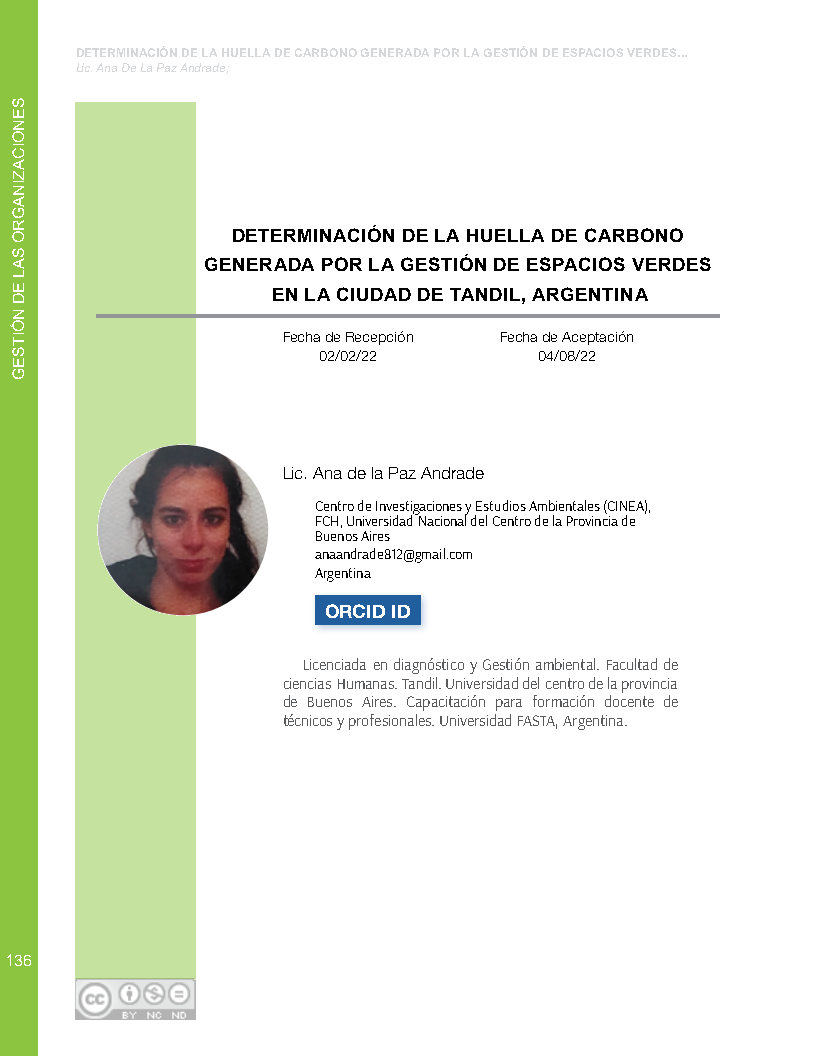Determining the carbon footprint caused by managing green spaces in the city of Tandil, Argentina
Keywords:
carbon emission, greenhouse gases, organic waste, pruning, maintenance of gardensAbstract
Cities produce a diversity of waste, such as organic waste, which, when poorly managed, can generate Greenhouse Gas Emissions (GGE) that contribute to global climate change. The maintenance activities of public green spaces (GS) and private gardens in 2019 were considered in Tandil, an average city of 150,000 inhabitants located in the SE of the province of Buenos Aires, and the contributions of direct and indirect GGE from this waste were determined. The PAS 2050 methodology, used internationally for GGE certification purposes in the context of the Life Cycle of products and services, was used to account for the emissions. The equivalent emissions in tons of carbon were obtained from data related to the generation, composition, and treatment of this waste in the public and private spheres. Surveys were applied to private service providers and interviews with the management of green spaces in the municipality. As a result, a carbon footprint of green spaces and garden management of 425.28 TCO2 was obtained. The highest percentage of these emissions corresponds to indirect emissions associated with transporting and operating pruning machinery (diesel and gasoline). This is followed by emissions associated with irrigation by pumping water from the underground aquifer that is transported to its destination by truck. And in third place, there are the direct contributions of pruning and maintenance residues - grass clippings, leaves, branches, and shrubs
Downloads
References
Andrade, A. de L.P: (2019) Huella de carbono de residuos orgánicos en la ciudad de Tandil 2018 : el caso de la gestión de jardines y espacios verdes públicos y privados Tesis de grado. Fecha: 2019-11 Facultad de Ciencias Humanas, Universidad nacional del de Centro de la Provincia de Buenos Aires. Disponible en: https://www.ridaa.unicen.edu.ar/xmlui/handle/123456789/760/browse?type=author&value=Andrade%2C+Ana+de+la+Paz
Cadavid-Rodríguez, L. S., & Bolaños-Valencia, I. V. (2015). Aprovechamiento de residuos orgánicos para la producción de energía renovable en una ciudad colombiana. Energética, (46), 23-28.
El cronista digital (2018) Producción de basura: cuál es la realidad en Argentina y qué se podría hacer. https://www.cronista.com/responsabilidad/Produccion-de-basura-cual-es-la-realidad-en-Argentina-y-que-se-podria-hacer-20180302-0075.html
FAO (2011) Global food losses and food waste: extent, causes and prevention. Food and Agriculture Organization of the United Nations, Rome.
Hermann, B. G., Debeer, L., De Wilde, B., Blok, K., & Patel, M. K. (2011). To compost or not to compost: Carbon and energy footprints of biodegradable materials’ waste treatment. Polymer Degradation and Stability, 96(6), 1159-1171.
INDEC. (2022). Censo 2022. Resultados Previsionales. [En línea] Recuperado de http://www.indec.gov.ar/
Inventario Nacional de GEI España 1999-2021, inventario nacional de emisiones a la atmosfera. Emisiones de gases efecto invernadero. Ministerio para la transición ecológica y el reto demográfico. Secretaria de estado Y medio ambiente. Dirección de calidad y evaluación ambiental. Disponible: https://www.miteco.gob.es/es/calidad-y-evaluacion-ambiental/temas/sistema-espanol-de-inventario-sei-/Inventario-GEI.aspx
Ministerio de Energía y Minería de la Nación Argentina. (s.f). Ministerio de Energía y Minería de la Nación Argentina. https://www.minem.gob.ar/ (último acceso: Julio de 2016)
Oficina Catalana del Canvi Climátic (2012). Estrategia catalana de adaptación al cambio climático (escacc) https://www.google.com/url?sa=t&rct=j&q=&esrc=s&source=web&cd=&ved=2ahUKEwixu8zL4cX3AhVQLrkGHSHSADgQFnoECAUQAQ&url=https%3A%2F%2Fcanviclimatic.gencat.cat%2Fweb%2F.content%2F02_OFICINA%2Fpublicacions%2Fpublicacions_de_canvi_climatic%2FPlanificacio_i_estrategies_cc%2Fresum_executiu_escacc.doc_es.pdf&usg=AOvVaw1iC67i9dJSlMPywygg2fOQ
Rivas-Solano, O., Faith-Vargas, M., & Guillén-Watson, R. (2010). Biodigestores: factores químicos, físicos y biológicos relacionados con su productividad. Revista Tecnología en Marcha, 23(1), ág-39.
Salmeron Gallardo, Y. A., Cabrera_Cruz, R. B. E., Sampedro Rosas, M. L., Rosas Acevedo, J. L., Rolón-Aguilar, J. C., & Juárez López, A. L. (2017). Emisiones de Gases de Efecto Invernadero en Vertederos de Residuos Sólidos Urbanos Huella de Carbono en Acapulco, México.
Villalba, L., Donalisio, R. S., Basualdo, N. E. C., & Noriega, R. B. (2020). Household solid waste characterization in Tandil (Argentina): Socioeconomic, institutional, temporal and cultural aspects influencing waste quantity and composition. Resources, Conservation and Recycling, 152, 104530.

Downloads
Published
How to Cite
Issue
Section
License
Copyright (c) 2023 http://creativecommons.org/licenses/by-nc-nd/4.0/

This work is licensed under a Creative Commons Attribution-NonCommercial-NoDerivatives 4.0 International License.


